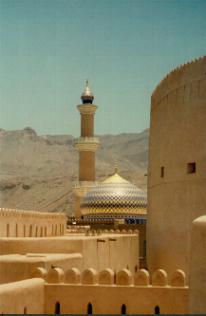
Mosque in Nizwa's Old City
 Mosque in Nizwa's Old City |
I've been fascinated by Oman ever since as a little girl I came across an old National Geographic magazine with an article on the Sultanate dated not long after the present Sultan Qaboos came to the throne. The story of his attempts to develop this small nation and bring it out of a global isolation which had earned it the title 'Hermit Kingdom' intrigued me.
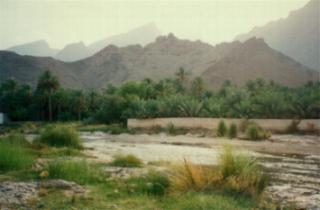 Jabal Akhdar Region |
In the mid-1990s there was another National Geographic article on Oman, about it's transformation from a backwater on the Arabian penisular struggling to put down a revolt by tribes near the Yemeni border, to a peaceful fairly prosperous country which had nevertheless succeeded in preserving it's rich heritage despite the dramatic change that had come over the country in only two decades. The photos showed beautiful landscapes and interesting buildings.I was intrigued all over again, I remember comparing the 70s article with the 90s one and marvelling at the change.
 Old Muscat |
In the summer of 1997 I made my dream come true. Well, summer isn't the ideal time to travel to Arabia, in fact it's a pretty lousy time to visit the Gulf, the heat is unbearable and the humidity in the coastal areas is suffocating. I don't think that I understood what heat and humidity really were until my Oman trip! Still, there are advantages to going off season - namely that my mother and I could afford it. The beauty of Oman and the fascinating cultural experience certainly made it worth our while to suffer the trials of an Omani summer.
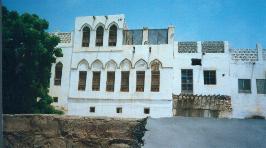 |
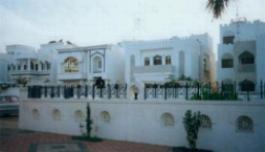 |
| Mutrah house | Medinat Qaboos Houses |
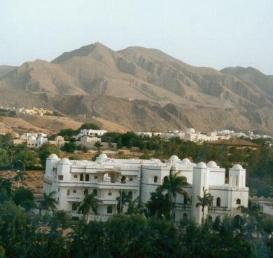 New Muscat suburbs |
We spent most of our time in and around the capital Muscat, also visiting parts of the Batinah coast north of Muscat and the inland area around Jabal Akhdar, the Green Mountains, esepcially welcome as the drier heat of the interior is much more pleasant than the humidity of the coast.
The Omani capital is dramatically located against the backdrop of dark craggy mountains on one side and the Indian Ocean on the other. The beaches are lovely, especially good for relaxing walks in the early evening when the weather gets a little cooler.
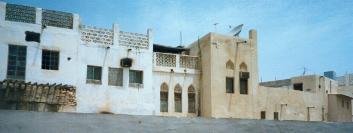 Houses behind the souk in Mutrah |
Muscat itself is technically the old port of Muscat, but today it is also used to refer to the greater Muscat area, including Mutrah, where the main souk and modern port area is and Ruwi,the central business district. Just north of these are several new neighbourhoods where many of the upscale hotels, foreign embassies and modern shopping malls are located. Each area has its own distinct character, the old walls and Sultan's palace in old Muscat, the souk and old houses around Mutrah, the modern but traditional style homes in Medinat Qaboos and other new suburbs and the more western looking office buildings of Ruwi.
 Museum door |
My favourite places in Muscat were the Mutrah souk and the various museums on Omani heritage and nature. I'm fascinated by traditional styles of jewellery, clothing, architecture and arts and crafts in general so Oman's rich variety of all of the above were especially thrilling. In particular I enjoyed the Omani Museum which included sections on Omani ship building, jewellery and architecture, as well as sections on Omani history and geography. The most stunning thing about this museum though is the wonderful carved wooden front door which the museum attendent kindly closed so that I could take a photo of it.
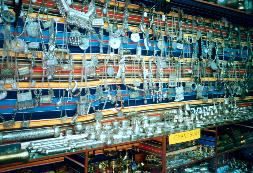 Mutrah souk silver shop |
I had a lot of fun browsing in the Mutrah souk, with its colourful displays of fabrics and traditional clothing, glittering gold jewellery shops and the enticing smells of the spice market. I spent ages browsing the various shops selling traditional style silver jewellery and ornaments, an Omani specialty. The designs are fascinating, many including brass or gold ornamentation work into the silver. Typical pieces include a variety of amulet holders, kohl boxes, incense burners, hair ornaments and all manner of heavy necklaces and evil looking bracelets decorated with spikes and thorns. My favourite piece was a circular hair ornament with a six sided star in the centre with the points highlighted with gold plate and the lower half of the circle ornamented with little chains holding 'hamsas' or 'hands of Fatima', a traditional good luck symbol in many parts of the Middle East.One of the most pleasant things about wandering the Mutrah souk was that unlike other souk that I've been to, here the merchants let you browse at will without pressuring you to buy.
 Khanjars on display in the souk |
The curved khanjar dagger, Oman's national symbol, is also available in a variety of designs in the souk silver shops. Some of the cheaper designs had plastic worked into the handle and flimsy blades, more expensive ones looked as thought they were meant for cutting steak, with very solid sharp blades and beautifully decorated handles, some including intertwined gold and silver threads. They were all pretty expensive though and I didn't feel like freaking out airport security by returning home with a dagger in my luggage!
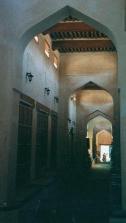 Nizwa Souq |
Another famous Omani product is incense, especially frankincense for which Oman is famous as the world's biggest producer. The frankincense resin producing trees only grow in two other places, the Hadhramaut region in Yemen and in northern Somalia. In ancient times frankincense made Oman rich, and it was exported all over the ancient world, supplying amongst other places the ancient Jewish Temple in Jerusalem and the temples of of Egypt, Greece and Rome. It was very special to finally see and smell this substance which is mentioned so many times in the Bible and which in the ancient Near East was more valuable than gold and precious gems. Another ancient incense, myrhh is also widely available in Oman. A verse from Song of Songs came to mind while I was wandering through the incense and perfume stalls in the souk: "Who is this is who comes up from the desert like pillars of smoke perfumed with myrhh and frankincense and all the merchants powders?" (Song of Songs 3:6). Now perhaps I have an idea what those smells were like.
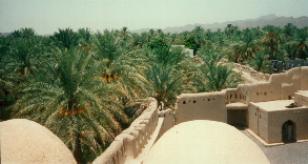 Nizwa date palms |
Oman is different from other Arab Gulf states in many ways. Oman has more limited oil reserves resources than most of it's neighbours. Its workforce includes a much lower proportion of foreign workers than the other Gulf states, though it does have a large expatriate community, mostly from the Indian sub-continent.
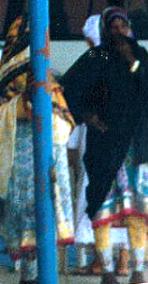 Women in the souq |
Oman is an Arab country, but its seafaring history and the legacy of its empire have meant that many Omanis, especially in coastal areas have mixed ancestry, often from Baluchistan or Persia, but there are also some who are descended from east African slaves. Most Omanis adhere to the Ibadi sect of Islam, the only Ibadi country in the world.
While the traditional clothing in other Arab Gulf countries is identical, Omanis have a more varied style, with the men wearing shirt dresses in various colours with ornate skullcaps or turbans and the women wearing bright colourful dresses and shawls, often with embroidered trousers underneath, though around Muscat I noticed some wearing the more 'sophisticated' black abbaya cloak worn in other parts of the Gulf. Even in the big cities most Omanis I saw, men as well as women, wore traditional dress, though some younger men and women wore western dress.
 Barka Fishermen |
I didn't spend all my time wandering the souk though, far from it. I did several day trips outside the capital visiting various villages and towns of interest. We visited the fish market at Barka and watched fishermen bring in their boats straight to the beach front market place.I guess I just enjoy the hustle and bustle, colour and noise of the marketplace, I find it interesting to see how regular people live rather than to just spend my time visiting national monuments and tourist sites, though I enjoyed these as well.
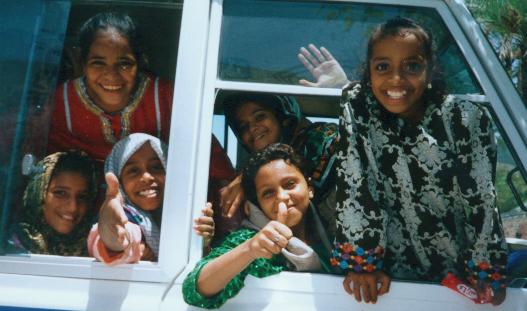 Omani schoolgirls |
The countryside around Jabal Akhdar is a mixture of barren desert and lush oases with date palms and gently rushing water. I spent a nice morning at the A'Thowarah oasis near the village of Nakhal. It was refreshing to relax by the water and enjoy the shade of the palms. A local group of schoolgirls was also visiting that morning and upon seeing my camera they besieged me with requests that I take their photo.
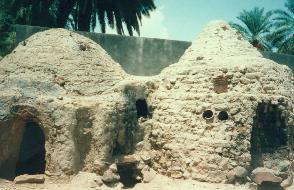 Firing kilms |
We stopped at various villages and towns in the interior regions, including one where we visited a pottery workshop. The guide searched in vain for the potter to come and show us his craft but all he could come up with was the potter's teenage son who rather grudgingly marched us across the village to the workshop and gave us the tour of the place. The most interesting part of the visit was just walking around the town and seeing the inside of some of the local houses.
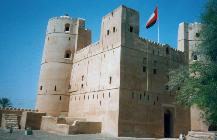 Barka Fort |
In particular I visited several forts. Over the centuries forts were built all over Oman because of its strategic location on the south-east corner of Arabia on the Straits of Hormuz and the Indian Ocean. Forts were built by the Omanis themselves, as well as a few built by the Portuguese during the 16th century. The forts were also the product of many turbulent periods in Oman's history during which the conservative interior and the more liberal coastal regions struggle for control of the country and the centres of power flitted back and forth between the coastal cities of Muscat and Sohar and the inland cities of Nizwa and Rustaq.
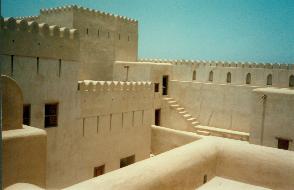 Nizwa Fort |
The fort at Nizwa is impressive if only for it's size and setting. The fort is huge and the jumble of corridors and staircases make it feel like a 3-D Escher picture. In one direction the fort's towers offer views of the town's chief landmark, an exquisite blue and gold domed mosque, and in the other there are views of the towns mud brick homes and groves of date palms. Dates are another Omani specialty and I visited at a time of year when the palms were heavy with fruit. The museum keeper offered visitors Arab coffee and fresh yellow dates in a shady corner of the fort, and I must say that those were some of the best dates and certainly the freshest that I've ever tasted.
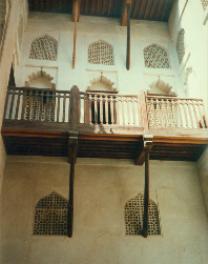 Courtyard at the Jibreen Fort |
The most beautiful fort that we visited was the recently restored Jibreen fort with it's colourful painted ceilings, delicate laticework windows, ornate doorways and shady inner courtyard. Inside the rooms are furnished with beautiful carved and decorated wooden tables, bright cushions and carpets and local pottery. Some ceilings and archways are decorated with verses from the Koran in ornate Arabic calligraphy. The overall feeling is of a well fortified but luxurious palace rather than a fortress. It certainly gives an insight into the lifestyle of imam and his family for whom the fort was originally built.
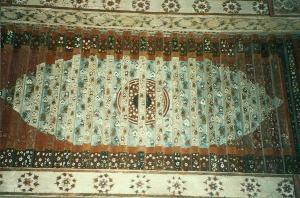 |
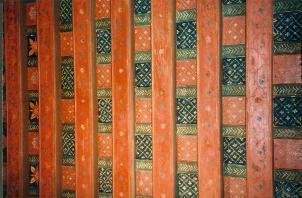 |
 |
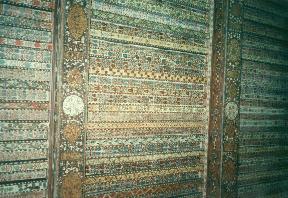 |
| Painted ceilings at Jibreen fort | |
Copyright 2000 by Leiah Elbaum. Text and photographs on this page are by Leiah Elbaum. Last updated 9 July 2000.